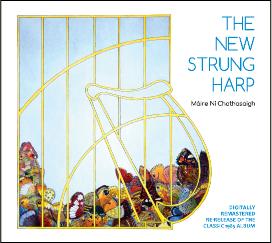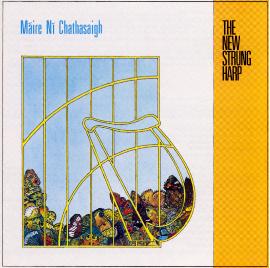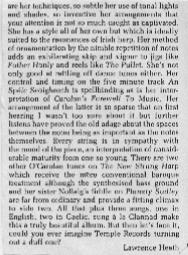|
|
||
 |
||||
TG4 Irish Traditional Musician of the Year 2001 |
||||
About The New Strung Harp The New Strung Harp, Máire's ground-breaking solo album, is of historical significance as the first harp album ever to concentrate on traditional Irish dance music. It was first released in 1985 by Scotland-based Temple Records to much critical acclaim. It was described as "An intensely passionate and intelligent record... a masterpiece of virtuosity... a milestone in Irish harp music" by the CORK EVENING ECHO (Ireland), as "A classic exercise in music-making" by THE SCOTSMAN, and as "Exquisite... exhilarating harp virtuosity... an undoubted classic" by THE IRISH PRESS. Before his death in 2021, Robin Morton, the owner of Temple Records, decided to wind up the company and very kindly gifted the the album rights back to the recording artists. The New Strung Harp has therefore been digitally remastered, given a new cover and artwork (though it still features the original cover painting by Colm Murphy) and re-released by Old Bridge Music on 8 September, 2023. Now available in CD and download format from our Old Bridge Music online shop. The reviewers said, the album's original release in 1985: "Extraordinary: a labour of love and a joy to the listener" IN DUBLIN Several of the harp arrangements have been published in The Irish Harper Vol. I. The album's title is a quotation from the late-18th century crest of the United Irishmen. This consisted of a representation of an old Irish harp and the motto: "Equality: it is New Strung and Shall be Heard". |
|||||||||
New artwork for the 2023 re-release! |
|||||||||
 |
|||||||||
The original 1985 album artwork |
|||||||||
 |
|||||||||
Now available in CD and download format from our Old Bridge Music online shop. |
|||||||||
Reviews of The New Strung Harp THE CORK EVENING ECHO (Ireland) Three songs are included and in one of these, "The Bantry Girls' Lament", she is joined by her sister, Nollaig, whose beautifully full sounding violin adds a richness to the song that others who have recorded it must envy. Throughout, Nollaig Ní Chathasaigh's contribution soars eloquently and it is one of the reasons that this record has a textural character all of its own. There are the almost mandatory O' Carolan pieces, and one of these "Planxty Sudley" is wonderfully expansive. Máire plays harp and synthesiser and Nollaig adds violin. Together they manage to produce an almost chamber orchestra-like sound. Ní Chathasaigh plays "Carolan's Farewell to Music" with a control and emotion that makes The New Strung Harp a milestone in Irish harp music." - Jack Power THE SCOTSMAN (Scotland) IN DUBLIN (Ireland) The New Strung Harp by Máire Ní Chathasaigh is a showcase for the extraordinary talents of the very best of these. Máire is already deservedly well-known for her live performances, and on this disc presents thirteen items, ranging from classic eighteenth century pieces to a street ballad. The variety is one of the attractions of the album: the instrument has long been used for the more lushly baroque of O'Carolan's pieces and the famous Moore's Melodies, but its use for the common people's dance tunes is a very recent innovation. How excellently it can suit them is shown here - throughout her dance tunes, Máire uses traditional techniques, particularly those of the pipes. This is no slight on her own instrument; rather it's an acknowledgement of how these tunes developed within the tradition and of the adaptability of the harp. In this respect she would have had no precedent, so it's also a considerable tribute to her talents as musician and arranger. The older music is also abundant. There are four of Carolan's pieces, covering a range from the elegance of "Planxty Sudley" to the more gauntly native "Farewell to Music". The classic harp tradition is represented by "An Spéic Seoigheach" from Bunting's collection, and there are some beautifully arranged songs. Máire's own sleeve notes will add considerably to the reader's knowledge, and they're not the least notable of the record's attractions. In all, the album is a labour of love and a joy to the listener." FOLK ROOTS (England) Here is a transcription of the review (the scan of the original is on the right): "So intricate are Máire Ní Chathasaigh’s techniques, so subtle her use of tonal lights and shades, so inventive her arrangements that your attention is not so much caught as captivated. She has a style all of her own but which is ideally suited to the resonances of the Irish harp. Her method of ornamentation by the nimble repetition of notes adds an exhilarating skip and vigour to jigs like Father Hanly and reels like The Pullet. She's not only good at rattling off dance tunes either. Her control and timing on the five minute track An Spéic Seoigheach is spellbinding as is her interpretation of Carolan's Farewell to Music—her sparse arrangement of which proves the old adage about the spaces between the notes being as important as the notes themselves. Every string is in sympathy with the mood of the piece, an interpretation of considerable maturity from one so young. There are two other O'Carolan tunes on The New Strung Harp which receive the more conventional baroque treatment although the synthesised bass ground and her sister Nollaig's fiddle on Planxty Sudley are far from ordinary and provide a fitting climax to side two. All that plus three songs, one in English, two in Gaelic, sung à la Clannad make this a truly beautiful album." FOLK ON TAP (England) TAPLAS (Wales) I hadn't been familiar with Máire's music before, but I had been told by friends to expect something extraordinary. This is the harp album I've been waiting for. I've always been fond of harps and harping, but have complained in the past that most folk harp records give the impression that harps were meant primarily for the playing of slow airs. This is, of course, not true. In Wales the harp was once the main instrument for dance and in Ireland the style of the old harpers was supposed to have been unusually quick and lively. This album has everything, from lively jigs and reels to slow airs and some of the best Gaelic singing you are ever likely to hear. There is a virtuoso rendition of what has long been my favourite jig, “The Humours of Ballyloughlin”; there are O'Carolan tunes, including lively ones like “Charles O'Connor” and slow ones like “Carolan's Farewell to Music”; there is a hornpipe set which I can't get out of my head, despite the fact that I've known both tunes - “The Fisherman's Hornpipe” and “The Cuckoo's Nest” - for years without the least problem. I even found myself playing the latter last night and, without realising it, trying to fit in some of Máire's harp variations and ornaments on the fiddle. I kept wondering why I was grinding to a halt! As well as Máire's harp playing, her lovely voice and some very tastefully - that is, sparingly - used synthesiser, we also get a sizeable portion of the rest of her family. Although, as I said earlier, I had been unfamiliar with Máire's playing until now, I have been an admirer of her sister Nollaig's fiddle playing for some years, ever since I first heard it on an album I picked up in Killarney by Danny Doyle, called "The Highwayman". One of the most notable things about Nollaig's playing is the feel of "swing" which is there even on slow numbers such as the last track on this album, O'Carolan's “Planxty Sudley”. Two other members of Máire's family are also on the album - her other sister Mairéad and her brother Greg, both of whom sing harmonies. Mairéad also plays tin whistle on the second track, a beautiful Gaelic song “Ó ho nIghean, É ho hIghean”. I really can't write any more about this lovely album. In the words of a friend of mine, "What can you say about it? It's perfect." THE IRISH PRESS (Ireland) THE GUARDIAN (England) THE IRISH TIMES (Ireland) SWAGBAG (England) |
"a milestone in
|
||||
|
||||||||||||||

FOLK ROOTS
April 1986